Implications of a multiscale structure of the yeast nuclear pore complex
- PMID: 37738963
- PMCID: PMC10630966
- DOI: 10.1016/j.molcel.2023.08.025
Implications of a multiscale structure of the yeast nuclear pore complex
Abstract
Nuclear pore complexes (NPCs) direct the nucleocytoplasmic transport of macromolecules. Here, we provide a composite multiscale structure of the yeast NPC, based on improved 3D density maps from cryogenic electron microscopy and AlphaFold2 models. Key features of the inner and outer rings were integrated into a comprehensive model. We resolved flexible connectors that tie together the core scaffold, along with equatorial transmembrane complexes and a lumenal ring that anchor this channel within the pore membrane. The organization of the nuclear double outer ring reveals an architecture that may be shared with ancestral NPCs. Additional connections between the core scaffold and the central transporter suggest that under certain conditions, a degree of local organization is present at the periphery of the transport machinery. These connectors may couple conformational changes in the scaffold to the central transporter to modulate transport. Collectively, this analysis provides insights into assembly, transport, and NPC evolution.
Keywords: AlphaFold2 modeling; FG repeats; computed structure models; cryo-EM; cryogenic electron microscopy; nuclear pore complex; nucleocytoplasmic transport; single-particle analysis.
Copyright © 2023 Elsevier Inc. All rights reserved.
Conflict of interest statement
Declaration of interests The authors declare no competing interests.
Figures

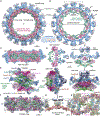
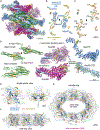
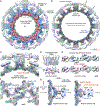
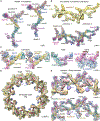
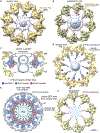

Similar articles
-
Architecture of the linker-scaffold in the nuclear pore.Science. 2022 Jun 10;376(6598):eabm9798. doi: 10.1126/science.abm9798. Epub 2022 Jun 10. Science. 2022. PMID: 35679425 Free PMC article.
-
Comprehensive structure and functional adaptations of the yeast nuclear pore complex.Cell. 2022 Jan 20;185(2):361-378.e25. doi: 10.1016/j.cell.2021.12.015. Epub 2022 Jan 3. Cell. 2022. PMID: 34982960 Free PMC article.
-
Structure of the cytoplasmic ring of the Xenopus laevis nuclear pore complex.Science. 2022 Jun 10;376(6598):eabl8280. doi: 10.1126/science.abl8280. Epub 2022 Jun 10. Science. 2022. PMID: 35679404
-
Cryo-electron Microscopy Reveals the Structure of the Nuclear Pore Complex.J Mol Biol. 2023 May 1;435(9):168051. doi: 10.1016/j.jmb.2023.168051. Epub 2023 Mar 17. J Mol Biol. 2023. PMID: 36933820 Review.
-
Structure and Assembly of the Nuclear Pore Complex.Annu Rev Biophys. 2019 May 6;48:515-536. doi: 10.1146/annurev-biophys-052118-115308. Epub 2019 Apr 3. Annu Rev Biophys. 2019. PMID: 30943044 Review.
Cited by
-
Overlapping nuclear import and export paths unveiled by two-colour MINFLUX.Nature. 2025 Apr;640(8059):821-827. doi: 10.1038/s41586-025-08738-0. Epub 2025 Mar 19. Nature. 2025. PMID: 40108461 Free PMC article.
-
Visualizing nuclear pore complex plasticity with pan-expansion microscopy.J Cell Biol. 2025 Sep 1;224(9):e202409120. doi: 10.1083/jcb.202409120. Epub 2025 Jun 12. J Cell Biol. 2025. PMID: 40504117
-
The Molecular Architecture of the Nuclear Basket.bioRxiv [Preprint]. 2024 Mar 28:2024.03.27.587068. doi: 10.1101/2024.03.27.587068. bioRxiv. 2024. Update in: Cell. 2024 Sep 19;187(19):5267-5281.e13. doi: 10.1016/j.cell.2024.07.020. PMID: 38586009 Free PMC article. Updated. Preprint.
-
Visualizing nuclear pore complex plasticity with pan-Expansion Microscopy.bioRxiv [Preprint]. 2025 Apr 7:2024.09.18.613744. doi: 10.1101/2024.09.18.613744. bioRxiv. 2025. Update in: J Cell Biol. 2025 Sep 1;224(9):e202409120. doi: 10.1083/jcb.202409120. PMID: 39345637 Free PMC article. Updated. Preprint.
-
The molecular architecture of the nuclear basket.Cell. 2024 Sep 19;187(19):5267-5281.e13. doi: 10.1016/j.cell.2024.07.020. Epub 2024 Aug 9. Cell. 2024. PMID: 39127037 Free PMC article.
References
Publication types
MeSH terms
Substances
Grants and funding
LinkOut - more resources
Full Text Sources
Molecular Biology Databases
Miscellaneous

